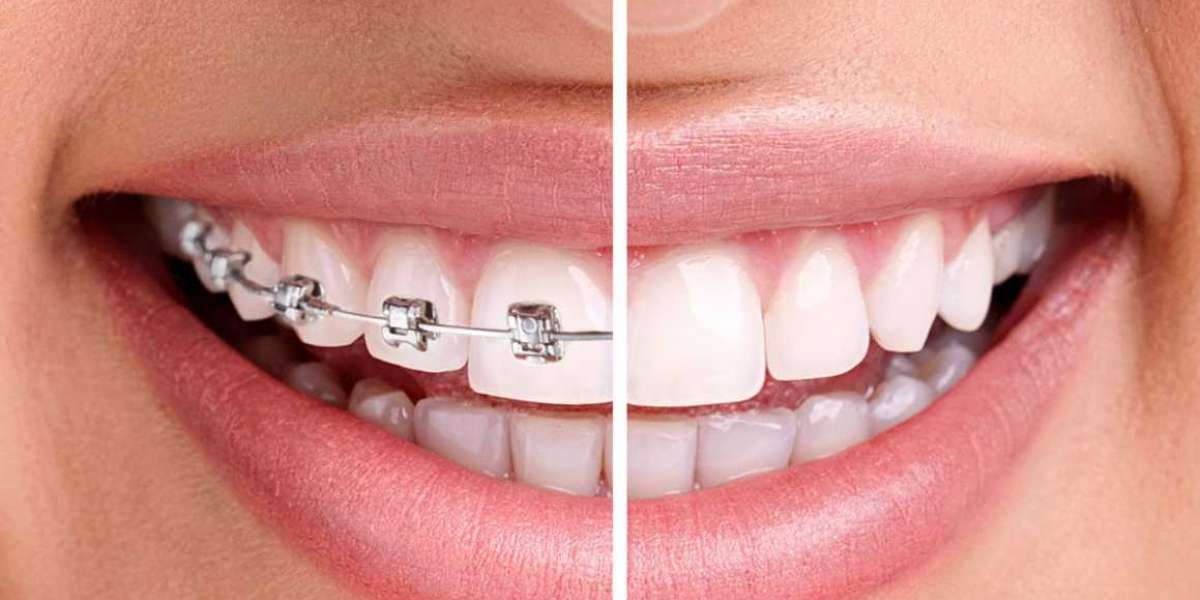Underbites, overbites and teeth that are crooked, crowded or have large gaps can all be treated with braces. There are just as many options in braces as there are problems they solve.
Parents of today had far less choice as teenagers; it was just the standard metal braces available back then. Now, their children can be fitted with a range of different options in braces.
Orthodontist have developed new treatments over the years to improve the aesthetics of braces. But choosing the right treatment method takes time and careful consideration.
Types of Braces
The most commonly used types of braces are:
Metal Braces
These are the traditional braces made of high-quality stainless steel. An arch wire is attached to brackets on the teeth which provides even pressure to move teeth in the correct direction.
Ceramic Braces
Using tooth-coloured ceramic brackets rather than metal and a white wire, ceramic braces are an appealing option for many patients. Also called clear braces, ceramic braces are virtually invisible. They are a popular choice for adults who prefer the subtle look compared to metal braces. Ceramics are also ideal for patients that like to have their photo taken or will attend important events while they are wearing braces.
Lingual Braces
Also called inside braces, lingual braces are custom made brackets designed to fit the contour on the inside of each tooth. A wire joins the brackets together and pulls the teeth into position by pulling from the inside. Just as effective as standard outside braces, however they take longer to fit as each bracket needs to be custom made. Appointments with lingual braces may also need to be more frequent and take longer than traditional braces.Lingual braces may also be more challenging to keep clean and may affect the speech in some patients.
Lingual braces are most common amongst adults who are self conscious of how they will look with traditional braces, particularly in the workplace. Lingual braces are virtually undetectable but users may need to wear elastic bands which people can see.
Invisalign
Invisalign is one of the newest options available. The patient wears a series of custom plastic trays for two weeks each which slowly move the teeth into the preferred position. The aligners are virtually invisible and are more comfortable to wear with no metal parts to rub against gums and inside the mouth. The patient doesn‘t need to make any changes to their diet and can clean their teeth as they always have because the Invisalign retainers are removed for eating and cleaning.
Which One Should you Choose?
It’s not just the aesthetics of the braces that will determine which one you choose. There are a few factors you should consider including cost, hygiene and the final result.
Aesthetics
In our experience, some patients worry unnecessarily about how they will look with braces. They can remain self conscious about the braces long after everyone else has forgotten about them. But if the look of the braces is a concern for you, then consider lingual or ceramic braces that are invisible or hardly noticeable.
Budget
Some treatment options are more expensive than others. If you aren’t the person paying for them then you may need to check if some options are not feasible due to their additional cost.
Due to the technology required to customise the brackets and the time it takes in the lab to make the brackets, the cost of lingual braces is higher than other orthodontic treatments. Ceramic braces are more expensive than metal braces due to the materials.
Self-Ligating Braces: All You Need to Know
Self-ligating braces look like conventional braces and are placed relatively the same way. The exception is that self-ligating braces don’t use elastics (rubber bands), or metal ties. Instead this system uses special clips or brackets with a spring-loaded door. The brackets maintain pressure on the archwire, helping move your teeth along at a steady pace.
Self-ligating braces are capable of correcting certain complex malocclusion (misaligned bite) issues and may be a viable option for patients with unique circumstances.
How Long Do Self-Ligating Braces Take?
Generally, self-ligating braces takes about the same amount of time to achieve the same results that you would get from the conventional treatment. On average, you’re looking at being in braces between 12 to 30 months.
The appointments themselves for self-ligating braces are roughly the same length as with traditional braces. The same is true of the intervals between appointments.
When you come in for an initial consultation and our orthodontist evaluates your condition, we will have a good idea of how long your treatment will take.
Do Self-Ligating Braces Need Tightening?
While self-ligating braces do require adjustments, they do not get “tightened” the same way as traditional systems. The spring-loaded doors “tighten” the wires in place instead of an elastic tie.
What Do Self-Ligating Braces Cost (Are They More Expensive)?
When it comes to the functionality and look of your smile, the results you get from orthodontics is priceless. When you choose to make an investment in yourself that will last a lifetime, you’ll want to ensure that you’re receiving the best treatment possible.
That being said, the cost of self-ligating braces is very comparable to that of conventional braces, and even clear aligner therapies like Invisalign. Self-ligating braces typically cost between $3,500 and $8,500.
Many dental insurance policies will help cover at least a portion of the cost of your orthodontic treatment.
For the remaining balance, we offer affordable payment options for every budget.
All of your treatment costs and financing options will be discussed with you ahead of time. Following your free initial consultation, we won’t move forward until you’re comfortable with the arrangements that have been made.
Everything You Need to Know About Metal Braces
When it comes to straightening teeth, closing gaps, fixing overbites or correcting under-bites, metal braces are simple, effective and produce fantastic results. However, many patients really don’t know what to expect from orthodontic treatment, or what the differences are in the options they may have to choose from.
If you are considering having orthodontic treatments and are unsure about what to expect, and what the overall treatment process will be like, then this article will provide clarity and insights in to what the experience of having braces will mean for you.
There are many reasons that people choose to undergo orthodontic treatment, and there are also some instances where they may be required for specific medical or dental health concerns. Let’s take a look at some of the most common reasons that patients get braces.
The most common reasons that people get braces is to straighten, align, and adjust gaps in their teeth. Braces are used to alter the position and alignment of teeth within the jaw, gradually closing gaps that are too big and repositioning teeth that may be too close together or crowded.
Braces are also commonly used to correct overbites or under-bites. These conditions result in the top and bottom jaws not aligning when biting down, which can have effects on speech and potentially result in discomfort when chewing.
For young patients whose teeth are growing in to spaces that are too small, braces can be used to open up the areas where new teeth are growing in. The purpose of this is to avoid more serious tooth alignment problems in the future once the full set of adult teeth are in place.
Other patients may be recommended to have braces as part of a treatment process intended to correct other oral health issues such as clenching or grinding of teeth. Often, misaligned teeth can be one of the contributing factors to these issues, and therefore should be corrected as part of the efforts to prevent the conditions from progressing.
Benefits of Orthodontic Treatment
Regardless of the underlying reason for having orthodontic treatment, whether it be for aesthetics or for medical necessity, you can look forward to many of the same advantages as a result. Obviously, one of the most prominent benefits to having braces is a straighter and more beautiful smile that will give you greater confidence and self-assurance in your appearance.
In addition, straighter teeth and a properly aligned bite pattern has a significant impact in the comfort and ease of chewing and may even allow you to enjoy certain foods that perhaps were awkward or uncomfortable to eat before your treatment. This improved alignment of the teeth can also result in a cessation of tooth grinding or clenching that would cause soreness in the jaw or recurring headaches.
The Pros and Cons of Ceramic Braces
Less painful: According to people who have worn both metal and ceramic braces, ceramic braces are less painful on your gums and cheeks because the ceramic is not as harsh.
Hard to notice: One of the things that make people avoid getting braces even when they need them is the fact that they are visible and can be embarrassing, especially for adults. The brackets used for ceramic braces can be color-matched to your natural teeth, making them difficult to notice at a distance.
Very durable: Some people are wary about getting ceramic braces because they do not think that they are durable or will last through the treatment without having to be replaced. Fortunately, ceramic braces are hard to damage and will last throughout your treatment.
Cost effective: Ceramic braces are a little more expensive than metal braces, but they are still a cost-effective method of fixing crooked teeth when compared to alternatives like clear aligners, which cost more and take longer to achieve the desired effect.
How Do Lingual Braces Work?
Specialists Orthodontists can provide a wide range of benefits to both functional and aesthetic aspects of oral healthcare. These professionals are expertly trained to ensure proper alignment and straightening of your teeth, regardless of your unique situation. This specialist dentist possesses the necessary knowledge and skills beyond the standard dental school curriculum, meaning they can diagnose, prevent and treat all types of facial and dental irregularities.
If you are on this page, then it is highly likely that you have been offered, are considering, or are currently going through lingual brace treatment. Lingual braces are one of the many treatments on offer by orthodontists which may be authorised as means of straightening your teeth.
Misaligned teeth, gaps in teeth or overcrowded teeth are some of the most frequent issues which result in lingual braces being provided for patients. But how do lingual braces work? And how do they differ from other types of braces as an orthodontist procedure? These questions will be explained in full by our oral care professionals in the following blog.
Lingual braces and conventional braces hold a lot of similarities in terms of their excellent control of both the crown and the root of the tooth. This allows controlled tooth movement whilst working alongside a cosmetic dentist, or other dental specialist.. The major difference between conventional braces and lingual braces are that the latter are the only truly invisible brace out there.
The only person who is going to be aware of lingual braces is the individual patient them self. These invisible braces are the perfect solution for adults who do not want other people to be aware of their braces, as they will be completely hidden from view. Despite their clear long term benefits, some patients consider traditional braces to be too unsightly in the short term. This may be because they work in a job where their image is particularly important, or they are worried about feeling self-conscious due to this temporary change in their appearance. Lingual hidden braces ensure that your self-image isn’t compromised for teeth alignment. We use the Incognito system; the global leading lingual system is digitally planned and fully customised and individua lfor each patient, whilst possessing all of the qualities of conventional fixed braces.
Because lingual braces have a near-identical mechanism to conventional braces, they are just as effective at moving and aligning teeth into the correct position. This procedure is far more effective than aligners for complex movements like altering the heights of teeth, closing gaps, problems with over/underbites and correcting rotations or root position. Another benefit of this orthodontic procedure is that a predictable outcome and predictable timeline can be produced by working with an experienced lingual braces London orthodontist.








